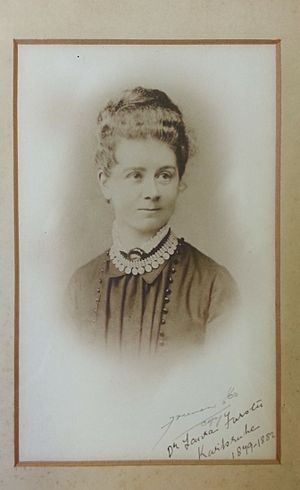Laura Forster facts for kids
Laura Elizabeth Forster (1858–1917) was an amazing Australian medical doctor, surgeon, and nurse. She is remembered for her brave work in countries like France, Belgium, Turkey, and Russia during World War I.
Early Life and Learning
Laura Elizabeth Forster was born in 1858 in a place called Ryde, near Sydney, Australia. Her father, William Forster, was a landowner, a poet, and even the leader of New South Wales for a short time (called the Premier of New South Wales). Laura was one of six children from her mother, Eliza Jane Wall.
After her mother passed away, Laura's father married again. Laura went to schools in Sydney until about 1879. Later, in 1887, she moved to Switzerland to study medicine at the University of Bern. She spent many semesters there, studying and researching. She finally graduated in 1894 and was allowed to work as a doctor in the United Kingdom the next year.
Her Career as a Doctor
After becoming both a doctor and a nurse, Laura Forster settled in England. She worked as a doctor in Oxford. She was also approved by important medical groups in Glasgow and Edinburgh. In 1900, she became a medical officer at a place called the Cutler Boulter Dispensary in Oxford.
Laura was very interested in understanding how certain diseases affected women. She even did special studies in a lab in London, looking at samples from about 100 women. In 1907, she published a research paper about her findings.
Between 1910 and 1911, Laura Forster spent several months in Madrid, Spain. She worked in the lab of a very famous scientist, Dr. Santiago Ramón y Cajal. He was a world leader in studying the brain and nerves, and he had even won the Nobel Prize in 1906! Laura published her third scientific paper, which was written completely in Spanish, based on her work there. She studied how nerve fibers heal after injuries in birds, comparing it to what was known about mammals. Her work showed that the process was similar, but faster in birds. She thanked Dr. Cajal for his help and advice.
In 1912, when the First Balkan War started, she traveled to Epirus to help. She worked as a nurse because, at that time, women were not allowed to be doctors on the front lines of war.
War Service During World War I
When World War I began in September 1914, Laura Forster started working for the British Red Cross. She was at a Belgian Field Hospital in Antwerp. She was the first Australian female doctor to go to Belgium to help with the war effort. This was a time when women doctors were not allowed to join the main Allied Medical Corps.
When German forces bombed Belgium in 1914, Laura and her team bravely helped move Belgian and British soldiers to safety, even under heavy attack. After the bombing, she went to France to help Belgians who were hurt.
Next, she moved to Russia. She volunteered in the surgery department of the biggest hospital in Petrograd. She became the first Australian or British female surgeon to perform operations there! She stayed for several months before joining the Russian Red Cross to work in the Caucasus region.
From there, she went to Erzurum, Turkey. She was in charge of a field hospital that had 150 beds. This hospital treated people with Typhus, a very serious disease. By the summer of 1916, about 70 percent of the 40,000 people infected in the city, including refugees, soldiers, and residents, were affected by typhus.
In September 1916, she joined a hospital unit that was paid for by the National Union of Women's Suffrage Societies. This group used donations from wealthy people in Britain to help wounded soldiers and refugees. Laura was then put in charge of a hospital in Zalishchyky, in a region called Galicia.
At Zalishchyky, the hospital unit was named the Millicent Fawcett Hospital Unit, after a famous woman who fought for women's right to vote in England. Laura and her team treated thousands of civilians for diseases like typhoid, scarlet fever, and dysentery. They also treated farmers who had accidents. In addition to civilians, they cared for wounded Russian soldiers who came from the front lines, which were only 30 miles away. In December 1916, Laura moved to another part of the unit, an 80-bed hospital for epidemic diseases in Zalishchyky.
Death
Laura Forster was 58 years old. The very long days (sometimes 20 hours), constant bombings, and the huge number of sick and wounded people made her very tired and thin. She passed away on 11 February 1917 in Zalishchyky. She died from heart failure after being sick with influenza for a week.
She was buried in Zalishchyky with Russian traditions, which included being buried in an open coffin with Russian Orthodox Church icons. Nurses from the hospital she ran placed a homemade Union Jack flag over her body. Her research findings from the Claybury Asylum pathology laboratory were published after her death in 1917.


